Hawaii or bust: A traveler’s notebook as he successfully navigates Hawaii’s pre-travel testing program
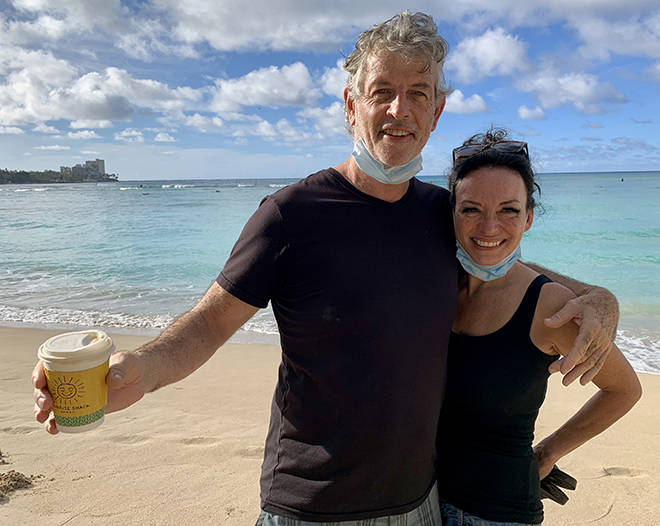
ERICK BENGEL / SPECIAL TO THE STAR-ADVERTISER
Ventura, Calif., residents Peter Forster, left, and Diane Roos, enjoy Waikiki Beach on Friday morning. The couple arrived the previous morning, the day the state opened to tourists who had pre-tested negative for COVID.
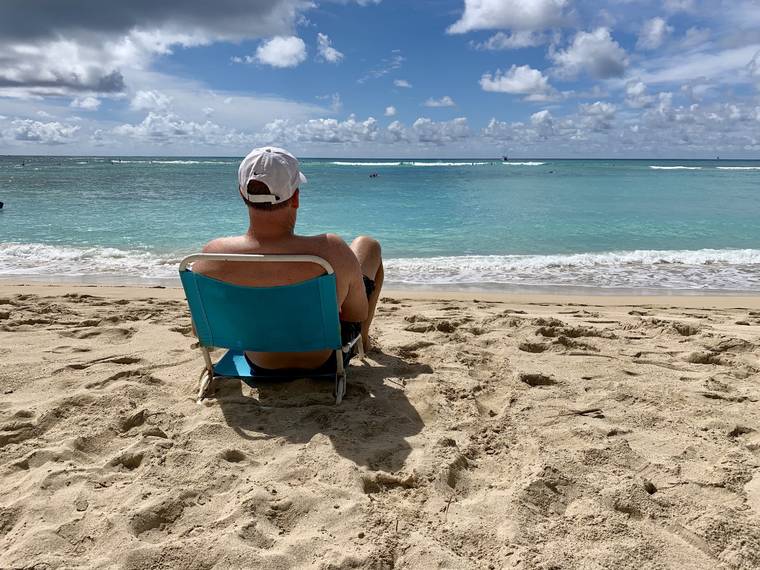
ERICK BENGEL / SPECIAL TO THE STAR-ADVERTISER
Dave Richards, who lives on the North Shore, watches the waves on Waikiki Beach.
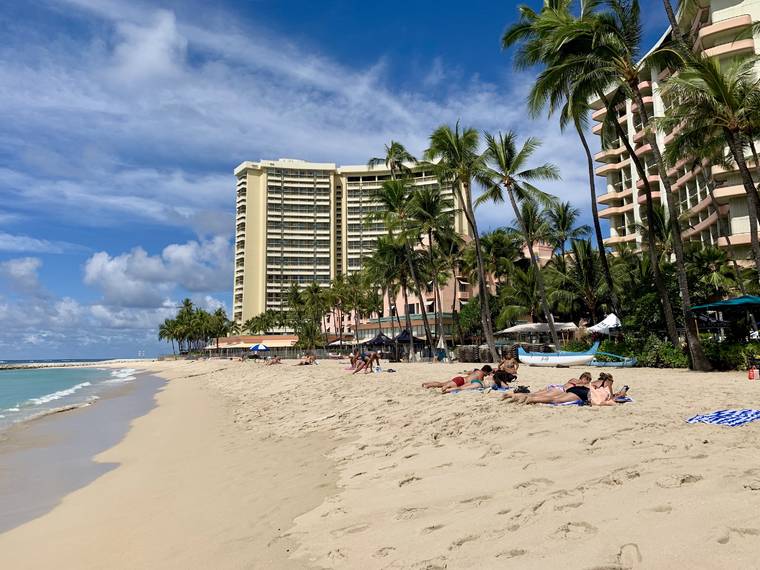
ERICK BENGEL / SPECIAL TO THE STAR-ADVERTISER
Beachgoers at Waikiki were few and spread out the day after the state opened for tourists pre-tested for COVID-19.
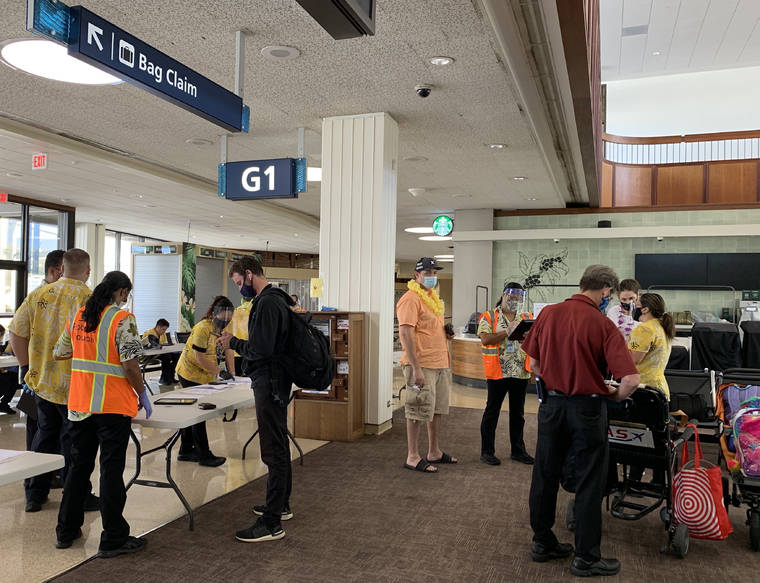
ERICK BENGEL / SPECIAL TO THE STAR-ADVERTISER
Passengers arrive and are processed in Daniel K. Inouye International Airport on Thursday, the first day of Hawaii’s pre-travel testing program that allows visitors with a recent negative coronavirus test to avoid quarantine.
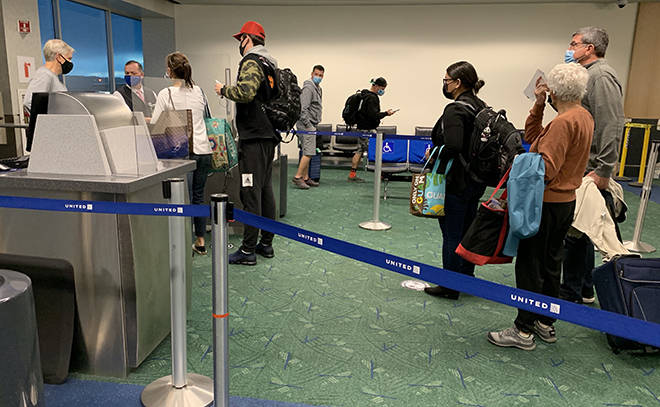
ERICK BENGEL / SPECIAL TO THE STAR-ADVERTISER
Passengers board a Hawaii-bound flight at the Portland International Airport on Thursday, the first day of Hawaii’s pre-travel testing program that allows visitors with a recent negative coronavirus test to avoid quarantine.
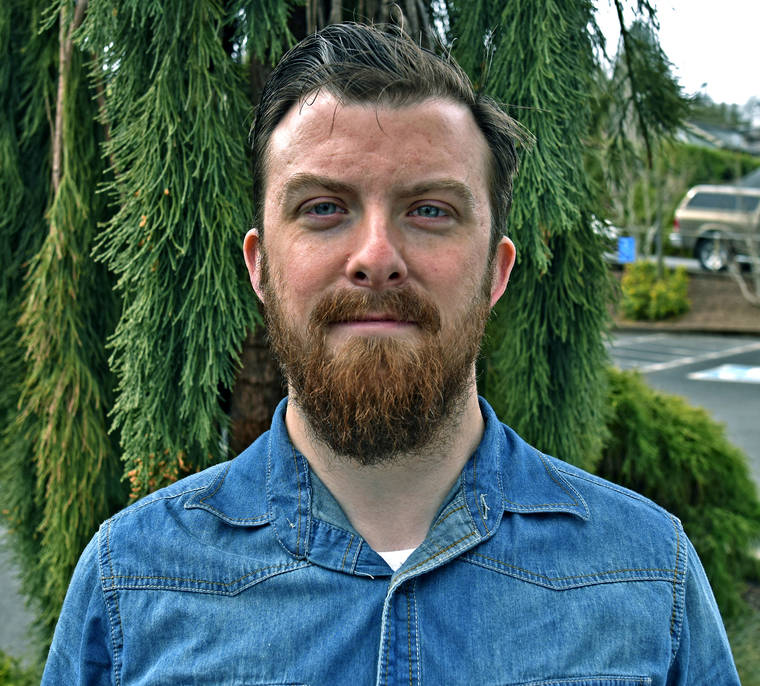
ERICK BENGEL






Editor’s note: Freelance journalist Erick Bengel is on assignment for the Honolulu Star-Advertiser, standing in for Hawaii-bound travelers trying to navigate the state’s pre-travel testing program that starts Thursday. Follow his journey from Portland, Ore., to Honolulu, with a stopover in San Francisco, at staradvertiser.com.
FRIDAY (In Waikiki)
On Thursday, — the day Hawaii opened up to tourists who had pre-tested negative for COVID and therefore didn’t have to quarantine upon arrival — Peter Forster and Diane Roos, of Ventura, Calif., flew in from Los Angeles International Airport, touching down in Honolulu before noon.
The next morning, beneath benign, painterly clouds, the couple sat near the tideline on Waikiki Beach. Out in the swells, people surfed and SUPed.
Forster said the scene resembled what Waikiki looked like before it exploded as a tourist destination. A strand where beachgoers were spread out and could walk around without hundreds of people underfoot.
“I’ve never seen it like this,” Forster said. “It’s like a wonderful time turn-back.”
Don't miss out on what's happening!
Stay in touch with breaking news, as it happens, conveniently in your email inbox. It's FREE!
Forster lived in Maui for about a year after high school in the mid 1970s. “Bummed around and surfed and learned about girls,” he recalled. “Still in the learning curve, though,” he said, glancing at Roos.
I asked what their travel preparation was like. “It was very challenging,” Roos said. Especially making sure they’d scheduled the right COVID test to meet the state’s requirements.
The Hawaii Safe Travels website, though? “I thought it was easy,” Forster said.
They’d heard something about the National Guard planning to take their temperatures when they arrived. But the Guard wasn’t there, nor was anyone interested in their temperatures. Instead, they had the same experience I did: a nice lady checked their COVID test results in the QR code on their phones. They went right through.
Forster and Roos plan to be in Hawaii for two weeks of camping in Oahu and Maui.
I asked if there’s anything they wanted to add: “That we love Hawaii, and that it’s proof that God might exist,” Forster said.
A few hours later, the open sun was beating down. Beachgoers were few and keeping to themselves. With nothing left to do but wait to catch my plane home, I walked down to the sand behind Duke’s Waikiki and, for the first time since I landed, stuck my feet in the ocean.
THURSDAY EVENING (Arrival)
If I had been a mite overwhelmed by the steps involved in visiting Hawaii sans quarantine — if I felt my soul sinking as I watched my Google Chrome tabs proliferating like self-replicating nanobots as I worked to crack this process — I responded by making sure I took every step, even redundant ones. I probably didn’t need four QR codes.
But the result when I finally landed at Daniel K. Inouye International Airport the afternoon of Oct. 15, after catching my transfer in San Francisco, was more or less as promised: an orderly move through passenger verification.
Upon debarking, the people planning to stay on the island formed a line, which snaked through the terminal, and were screened by employees of the state Department of Transportation and Roberts Hawaii.
Most new arrivals seemed prepared to be patient for a while. Law enforcement officers watched the action from the sidelines.
The big line broke into separate lines for people who didn’t have their QR code, those who had their code but no COVID test results or proof of them, and those who had both their code and their test.
Tim Sakahara, a state Department of Transportation spokesman, noted that roughly 80 percent of passengers have had their negative test results on hand.
Suddenly the pieces of my week that took up so much space in my mind — COVID test results (choice of paper and PDF), proof of my lodging and return flight, one of those QR codes — played their part. In a way I was glad I stressed the experience: With my initial confusion surrounding this day and how I would navigate it — with everything that could go wrong, and very nearly did on my end — I fully expected to find myself bereft of some essential quality that would keep me out of Hawaii.
But here I am, in my room at the Outrigger Waikiki Beach Resort, free to walk about whenever I wish.
THURSDAY MORNING (Departure)
PORTLAND, Ore. >> The trip to Hawaii is, so far, a standard COVID-era flight. So far, no one has asked for my test results or checked my temperature.
At Portland International Airport, the visitors were overwhelmingly masked and the sanitizer dispensers were in frequent use.
It was a conscientious, sparsely populated terminal at 5:45 a.m., the travelers sitting with their coffee and smartphones and wrapped in their tired, early-morning unapproachability.
I asked Cliff Self and Danny Freitag, a married couple from Pacific City, Ore., heading to Hawaii, what if anything they had trouble with planning-wise. Did anything challenge or confuse them? How about the Hawaii Safe Travel website?
They looked quizzical, as if trying to understand my question. “It was really pretty easy, I think,” Self said. They felt the entire rigmarole, including the website, was fairly straightforward; the instructions were right there, they said.
One point of confusion for me was whether I needed to enter every flight on my journey as a “trip” on the Safe Travels site — which asks us to enter every “leg” — even the flights that don’t touch Hawaii.
To be thorough, I entered the Portland to San Francisco leg as a “trip” in case I needed the QR code at screening.
Self and Freitag had already intuited that it wouldn’t be necessary. They were right.
WEDNESDAY (Testing)
It was the eve of my Oct. 15 trip to Oahu to join the first wave of pandemic-era tourists, people pre-tested for COVID-19 and not subject to a mandatory fortnight in quarantine.
And I could feel in my bones that something, at some point, was likely to go wrong. A form I left unfilled, a box unchecked.
To ease my fears, earlier in the week I’d called the service desk of Hawaii Safe Travels, the website where visitors to the state are required to enter their travel and health information. I left two voice-mails over two days. Still no word. This despite the site’s promise that calls “outside of working hours will go to voice-mail and be returned the next business day.”
I am not a seasoned traveler. And given the stakes, I wanted a paid professional to reassure me that I’d done everything correctly. By 10:30 p.m. PST Wednesday, I knew this was probably not going to happen.
At least the COVID test was in the bag. The nearest clinics I could find that did the State of Hawaii-approved Rapid RNA Molecular test were all in the Portland, Ore., area, two hours from my home on the North Oregon Coast. I chose an AFC Urgent Care clinic.
But even that was a near-miss.
I made the appointment on Monday, even calling to confirm I had a test waiting for me. Then early Wednesday morning I received a text: “… This appointment has been cancelled. Please re-book online under ‘COVID TESTING.’ Thank you.”
Apparently I had booked incorrectly. And all the testing slots that day were filled. I called the clinic.
The office told me they had canceled more than 20 appointments recently because other people wanting COVID tests had done the same thing I did: clicked on a random service — from “URGENT CARE” to “OCCUPATIONAL THERAPY” — to get one. I’d clicked the former, thinking I was responsibly choosing AFC Urgent Care, one of the State of Hawaii’s “official testing partners.”
This error was happening so often that AFC finally added a cautionary pop-up to the non-COVID options to make sure people knew exactly what they were not signing up for.
The clinic made an exception and gave me my slot back after I defended my good-faith effort to verify I’d done everything right. They administered my test — a quintessential swab to the brain — in the parking lot. Results took about 15 minutes and cost $199 (fully covered by insurance).
I’m COVID-free and ready to fly.
Erick Bengel is a freelance journalist living in Astoria, Ore. He recently graduated from the Columbia Journalism School in New York.



